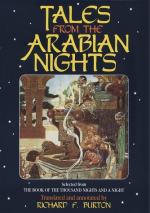In the 45th of Laura Gonzenbach’s “Sicilianische Mrchen,” the king’s daughter is stolen by a giant and recovered by the seven sons of a poor woman. The eldest can run like the wind, the second can hear, when he puts his ear to the ground, all that goes on in the world; the third can with a blow of his fist break through seven iron doors; the fourth is a thief; the fifth can build an iron tower with a blow of his fist; the sixth is an unfailing shot, the seventh has a guitar which can awaken the dead. Youths thus wonderfully endowed figure in many tales, but generally as the servants of the hero.
By comparing the different European versions it will be found that some are similar to the first part of the tale of Prince Ahmad, insomuch as the brothers become possessed of certain wonderful things which are each instrumental in saving the damsel’s life; while others more closely approach the oldest known form of the story, in representing the heroes as being endowed with some extraordinary kind of power, by means of which they rescue the damsel from a giant who had carried her off. It is curious to observe that in the “Sindibad Nama” version the damsel is both carried off by a demon and at death’s door, which is not the case of any other Asiatic form of the story.
Arabian Nights,
Volume 13
Footnotes
[FN#1] M. Zotenberg empowered me to offer his “Aladdin” to an “Oriental” publishing-house well-known in London, and the result was the “no-public” reply. The mortifying fact is that Oriental studies are now at their nadir in Great Britain, which is beginning to show so small in the Eastern World.
[FN#2] P.N. of a Jinni who rules the insect-kingdom and who is invoked by scribes to protect their labours from the worm.
[FN#3] Both name and number suggest the “Calc. Edit.” of 1814. See “Translator’s Foreword” vol. i., x)x.-xx. There is another version of the first two hundred Nights, from the “Calc. Edit.” into Urdu by one Haydar Ali 1 vol. roy. 8vo lithog. Calc. 1263 (1846).— R.F.B.
[FN#4] “Alf Leilah” in Hindostani 4 vols. in 2, royal 8vo, lithographed, Lakhnau, 1263 (1846).—R. F. B.
[FN#5] This is the “Alif” (!) Leila, Tarjuma-i Alif (!) Laila ba-Zuban-i-Urdu (Do Jild, baharfat-i-Yurop), an Urdu translation of the Arabian Nights, printed entirely in the Roman character, etc., etc.—R.F.B.
[FN#6] i.e., The Thousand Tales.
[FN#7] From the Ms, in the Bibliocheque Nationale (Supplement Arab. No. 2523) vol. ii., p. 82, verso to p. 94, verso. The Sisters are called Dinarzad and Shahrazad, a style which I have not adopted.
[FN#8] THe old versions read “Ornament (Adornment?) of the Statues,” Zierde der Pildsulen (Weil). I hold the name to be elliptical, Zayn (al-Din = Adornment of The Faith and owner of) al-Asnam = the Images. The omission of Al-Din in proper names is very common; e.g., Fakhr (Al-Din) Al-Iftakhari (Iftikhar-al-Din) and many others given by De Sacy (Chrest.i. 30, and in the Treatise on Coffee by Abdal-Kadir). So Al-Kamal, Al-Imad, Al-Baha are = Kamal al-Din, etc. in Jbn Khallikan, iii 493. Sanam properly = an idol is popularly applied to all artificial figures of man and beast. I may note that we must not call the hero, after Galland’s fashion, unhappily adopted by Weil, tout bonnement “Zayn.”




